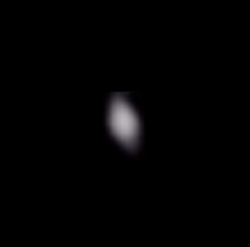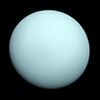Astronomy:Rosalind (moon)
- There is also an asteroid called 900 Rosalinde.
 The Hubble Space Telescope captured tiny Rosalind orbiting Uranus in 1997 | |
| Discovery | |
|---|---|
| Discovered by | Stephen P. Synnott / Voyager 2 |
| Discovery date | January 13, 1986 |
| Designations | |
Designation | Uranus XIII |
| Pronunciation | /ˈrɒzələnd/[1] |
| Adjectives | Rosalindian /rɒzəˈlɪndiən/[2] |
| Orbital characteristics | |
| Mean orbit radius | 69,926.795 ± 0.053 km[3] |
| Eccentricity | 0.00011 ± 0.000103[3] |
| Orbital period | 0.558459529 ± 0.000000019 d[3] |
| Inclination | 0.27876 ± 0.045° (to Uranus' equator)[3] |
| Satellite of | Uranus |
| Group | ring shepherd |
| Physical characteristics | |
| Dimensions | 72 × 72 × 72 km[4] |
| Mean radius | 36 ± 6 km[4][5][6] |
| Surface area | ~16,000 km2[lower-alpha 1] |
| Volume | ~200,000 km3[lower-alpha 1] |
| Mass | ~2.5×1017 kg[lower-alpha 1] |
| Mean density | ~1.3 g/cm3 (assumed)[5] |
| ~0.012 m/s2[lower-alpha 1] | |
| ~0.031 km/s[lower-alpha 1] | |
| Rotation period | synchronous[4] |
| Axial tilt | zero[4] |
| Albedo | 0.08 ± 0.01[7] |
| Physics | ~64 K[lower-alpha 1] |
Rosalind is an inner satellite of Uranus. It was discovered from the images taken by Voyager 2 on 13 January 1986, and was given the temporary designation S/1986 U 4.[8] It was named after the daughter of the banished Duke in William Shakespeare's play As You Like It. It is also designated Uranus XIII.[9]
Rosalind belongs to Portia group of satellites, which also includes Bianca, Cressida, Desdemona, Portia, Juliet, Cupid, Belinda and Perdita.[7] These satellites have similar orbits and photometric properties.[7] Other than its orbit,[3] radius of 36 km[4] and geometric albedo of 0.08[7] virtually nothing is known about Rosalind.
In the Voyager 2 images Rosalind appears as an almost spherical object. The ratio of axes of Rosalind's prolate spheroid is 0.8-1.0.[4] Its surface is grey in color.[4]
Rosalind is very close to a 3:5 orbital resonance with Cordelia.[10]
See also
References
Explanatory notes
Citations
- ↑ Benjamin Smith (1903) The Century Dictionary and Cyclopedia
- ↑ Bertrand Evans (1966) Teaching Shakespeare in the high school, p. 213
- ↑ 3.0 3.1 3.2 3.3 3.4 Jacobson, R. A. (1998). "The Orbits of the Inner Uranian Satellites From Hubble Space Telescope and Voyager 2 Observations". The Astronomical Journal 115 (3): 1195–1199. doi:10.1086/300263. Bibcode: 1998AJ....115.1195J.
- ↑ 4.0 4.1 4.2 4.3 4.4 4.5 4.6 Karkoschka, Erich (2001). "Voyager's Eleventh Discovery of a Satellite of Uranus and Photometry and the First Size Measurements of Nine Satellites". Icarus 151 (1): 69–77. doi:10.1006/icar.2001.6597. Bibcode: 2001Icar..151...69K.
- ↑ 5.0 5.1 "Planetary Satellite Physical Parameters". JPL (Solar System Dynamics). 24 October 2008. http://ssd.jpl.nasa.gov/?sat_phys_par.
- ↑ Williams, Dr. David R. (23 November 2007). "Uranian Satellite Fact Sheet". NASA (National Space Science Data Center). http://nssdc.gsfc.nasa.gov/planetary/factsheet/uraniansatfact.html.
- ↑ 7.0 7.1 7.2 7.3 Karkoschka, Erich (2001). "Comprehensive Photometry of the Rings and 16 Satellites of Uranus with the Hubble Space Telescope". Icarus 151 (1): 51–68. doi:10.1006/icar.2001.6596. Bibcode: 2001Icar..151...51K.
- ↑ Smith, B. A. (1986-01-16). "Satellites of Uranus". IAU Circular 4164. http://www.cbat.eps.harvard.edu/iauc/04100/04164.html#Item1. Retrieved 2011-11-01.
- ↑ "Planet and Satellite Names and Discoverers". Gazetteer of Planetary Nomenclature. USGS Astrogeology. July 21, 2006. http://planetarynames.wr.usgs.gov/Page/Planets.
- ↑ Murray, Carl D.; Thompson, Robert P. (1990-12-06). "Orbits of shepherd satellites deduced from the structure of the rings of Uranus". Nature 348 (6301): 499–502. doi:10.1038/348499a0. ISSN 0028-0836. Bibcode: 1990Natur.348..499M.
External links
 |



